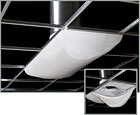
When homeowners in Tipp City, Ohio, added a pool house to their existing home, they needed to control the humidity. This 10-ft-diameter Isis fan was specifically designed for high-end residential and commercial spaces.
Just about every U.S. industry has been coming up with new ways of applying their older products, changes often prompted by the economy and energy trends these days. Don’t get me wrong - these new products fill legitimate customer needs.
HVAC is no different. These two examples are a microcosm of what’s been going on in two areas of air distribution products: fabric ductwork and one Big Ass fan. Their common thread: solving customer problems.
SMALL SPACE, BIG FAN
One fan manufacturer more commonly associated with the commercial-industrial market is dipping a toe into the high-end residential market. What happened was that in Tipp City, Ohio, some homeowners added a 1,095-square-foot pool house to their existing home and they needed to control the humidity.“Air circulation and humidity control in this space was a concern,” said Alex Reed of Big Ass Fans. “They considered using multiple small ceiling fans but they did not like the look. They wanted a contemporary and effective solution.”
The project eventually required a single Isis fan, instead of multiple smaller ceiling fans. The fan helps maintain proper humidity levels in the room, Reed explained, by forcing humid air trapped in the vaulted ceiling down, and triggering a humidity monitor that opens the exhaust fan. The 10-foot-diameter Isis fan was specifically designed for high-end residential and commercial spaces. Its airflow covers an area of 40-by-40 feet; it’s quiet (less than 40 dBa); and its anodized aluminum finish provides a moisture barrier for the space humidity.
The space does not have its own cooling system; the humidity control is sufficient for comfort, so this is a net energy saving for the structure, Reed said. The space does have underfloor geothermal heat.
The company said the fan also works well in low-ceilinged commercial applications. It ranges in size from 8 to 10 feet. “This fan moves air slowly and smoothly,” Reed said, “causing nondisruptive airflow that increases comfort and the efficiency of the mechanical system.
“Many contractors are aware of the benefits of Big Ass Fans in large industrial and commercial spaces,” he added, “but this project demonstrates that the same principles can be applied to high-ceilinged residential applications such as pool rooms, lofts, great rooms, and patios.”

LabSox is installed in front of laboratory fume hoods. A piece of fabric mesh with no metal plenum breaks up the air.
FABRIC DUCT BRANCHES OUT
Fabric duct has become pretty well established for commercial projects such as natatoriums, as well as for architectural applications, where the ability to customize the appearance of the fabric can be a big plus to the customer.“Fabric duct is commanding nearly a 20 percent market share of the open-architecture ceiling market,” said Cary Pinkalla, president and CEO of DuctSox. “Now we’re starting to utilize fabric in critical environments.”
LabSox is installed in front of laboratory fume hoods. Using a piece of fabric mesh with no metal plenum, “You break up the air,” he said; “we can eliminate any risk of turbulent and uneven air.” Another potential application is in facilities that use electron microscopes. “They all fall under this umbrella of critical environments,” Pinkalla said. “In a lab, the big push is to cut down on energy use. We’re trying to cut down on the amount of air going up the hoods. Air is passing through the fabric at lower velocities.”
The product came about because “End users came to us with their problems,” which boiled down to not being able to control the air with more traditional diffusers.
Other innovations include the kitchen market (KitchenSox), and even the light commercial market. “SimpleSox is for the mechanical contractor that is part of build outs and other small projects,” said Pinkalla. The modular, configurable, adjustable fabric system is stackable, adjustable (designed like a standard metal ducting system), and perhaps most importantly, available without special ordering.
“We have fabric diffusers,” he added. Using the eight standard components, “you can design your own” - up to 63 different configurations. After it’s designed, it’s relatively easy to move and rearrange it, because the sections are all zipped together. “It’s part of the commodities market,” said Pinkalla, “but what we’re offering is unique.”
Finally, the company is looking into underfloor air distribution. “We’re using fabric duct to distribute the air to the remote corners with heavy heat loads,” he said. The ability to unzip and move sections of the duct can be an advantage “if you need to move cable in the same space,” he said. “We’re in some 20-story buildings and big office buildings.”
Publication date:09/27/2010

Report Abusive Comment